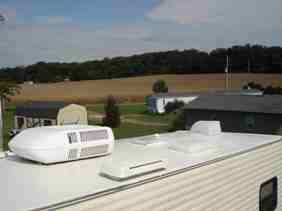Liquid RV Roof Coating Pros and Cons
Even the sturdiest RV roof will ultimately develop cracks and weaknesses due to prolonged exposure to extreme weather conditions.
To ensure that your RV’s roof remains in pristine condition, regular checkup and maintenance are necessary. In the event cracks develop on the roof, you can select from several RV rubber roof coating products available in the market. However, with so many roof repair products to choose from, people are expectedly confused on which ones deliver on their promise.
One of the well-known products in the market today is Liquid Roof RV roof coating. It is a liquid EPDM (Ethylene Propylene Diene Monomer), and therefore, possesses all the characteristics of EPDM when properly applied to the roof. When it cures, it offers the same advantages of an EPDM membrane, including flexibility and stability.
We reviewed the Liquid Roof RV roof coating and came up with its pros and cons. Here are what we found:
Strengths
- Versatile. It can be applied to virtually any surface such as fiberglass, fabric, sheet rubber, plywood and metal with the use of a brush, roller or squeegee. Most people prefer squeegee while others opt for a combination of brush and roller.
- Convenient. The product becomes water proof instantly after application, although there is a required curing time. The best part is that only one application is needed for total protection. It also self-levels once applied, thus minimizing on labor hours. You have plenty of time to properly apply the product before it cures.
- Economical. One gallon of RV roof coating covers 40 to 46 square foot. It lowers interior temperature by reflecting sunlight with its white color, which means huge energy savings.
- Total Protection. The product is resistant to ozone and Ultraviolet rays from the sun. It can withstand freezing snow, alkalis, acids and salt water. It also prevents ponding of water on the roof that could lead to leaks.
- Durable and Flexible. Liquid Roof remains flexible and durable at temperatures between -60°F to 300°F. The coat sinks into every crack and crevice in the roof, ensuring a water-tight application.
Weaknesses
If you buy a four-gallon container of the product, be sure to use it within a year from opening. Some people found the content separates into a rubbery top coat and white stuff underneath after some time. Others complain that applying the coat is slightly difficult because of its thickness.
Conclusion
The superior qualities and performance of Liquid Roof RV roof coating easily outweighs the very few apparent weaknesses of the product. In truth, these are not flaws that affect the quality of the product but merely the result of its improper use.
